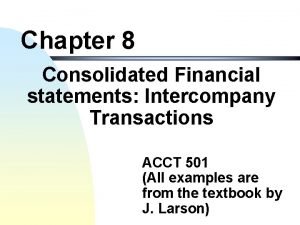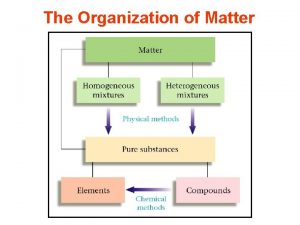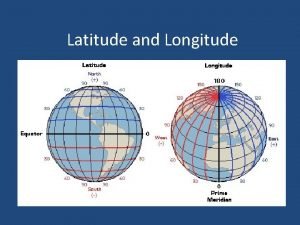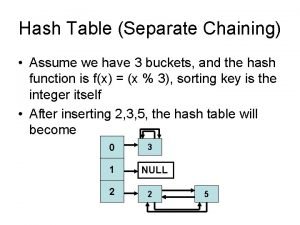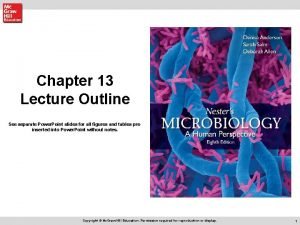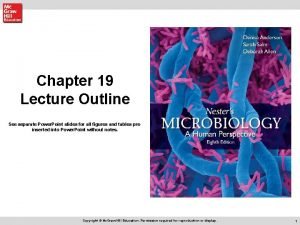Chapter 10 Lecture Outline See separate Power Point


































- Slides: 34

Chapter 10 Lecture Outline See separate Power. Point slides for all figures and tables preinserted into Power. Point without notes. Copyright © Mc. Graw-Hill Education. Permission required for reproduction or display. 1

A Glimpse of History § 1870 s: Bacteria classified by shape (Ferdinand Cohn) § 1908: Physiology rather than morphology (Sigurd Orla. Jensen) § 1930 s: Classification based on evolutionary relationships (Albert Kluyver, C. B. van Niel) § 1970: Relationships determined by comparing physical traits, nucleotide sequences (Roger Stanier) § Late 1970 s: Prokaryotes divided into two major groups based upon ribosomal RNA sequences (Carl Woese) • Led to current three domain system: Bacteria, Archaea, Eukarya

10. 1. Principles of Taxonomy § Taxonomy is the science that studies organisms to arrange them into groups, or taxa § Three separate but interrelated areas: • Identification • Process of characterizing in order to group • Classification • Arranging organisms into similar or related groups • Nomenclature • System of assigning names

10. 1. Principles of Taxonomy § Taxonomic Hierarchies • Species is basic unit: group of morphologically similar organisms capable of producing fertile offspring • Definition problematic for prokaryotes • Species is group of closely related isolates or strains • Informal groupings also used • May be genetically unrelated – Lactic acid bacteria – Anoxygenic phototrophs – Endospore-formers – Sulfate reducers • Kingdoms for prokaryotes still in state of flux

10. 1. Principles of Taxonomy § Phylogeny is evolutionary relatedness • Yields three-domain system based on Carl Woese et. al. • Replaces R. H. Whittaker’s five-kingdom system (1969)

10. 1. Principles of Taxonomy § Three-domain system based on evolutionary relatedness • Replaces five-kingdom system • Plantae, Animalia, Fungi, Protista, Prokaryotae • Based on obvious morphological differences • Does not reflect recent genetic insights of ribosomal RNA data indicating plants and animals more closely related than Archaea to Bacteria

10. 1. Principles of Taxonomy § Bergey’s Manual of Systematic Bacteriology • Describes all known species • Newest edition in five volumes • Classifies according to genetic relatedness • Previous edition grouped according to phenotype, so some major differences § Names given according to International Code of Nomenclature of Bacteria

10. 2. Using Phenotypic Characteristics to Identify Prokaryotes § Microscopic morphology § Culture characteristics § Metabolic capabilities § Serology § Fatty acid analysis

10. 2. Using Phenotypic Characteristics to Identify Prokaryotes § Microscopic morphology is important initial step • Quickly determines size, shape, staining characteristics • Sometimes enough to diagnose eukaryotic infections • Gram stain distinguishes between Gram-positive and Gram-negative bacteria • May suggest sufficiently to start appropriate therapy • Special stains (e. g. , acid-fast, endospore) useful

10. 2. Using Phenotypic Characteristics to Identify Prokaryotes § Culture characteristics can give clues • Streptococci colonies generally fairly small • Serratia marcescens colonies often red at 22°C • Pseudomonas aeruginosa often produces green pigment • Cultures also have distinct fruity odor • Differential media aids in identification • Streptococcus pyogenes (strep throat) yields β -hemolytic colonies on blood agar • E. coli (urinary tract infection) ferments lactose, forms pink colonies on Mac. Conkey agar

10. 2. Using Phenotypic Characteristics to Identify Prokaryotes § Metabolic capabilities • Biochemical tests provide more certainty of identification • Catalase test • Many rely on p. H indicators – Sugar fermentation – Urease production

10. 2. Using Phenotypic Characteristics to Identify Prokaryotes

10. 2. Using Phenotypic Characteristics to Identify Prokaryotes § Metabolic capabilities (continued…) • Basic strategy relies on dichotomous key • Flowchart of tests with positive or negative result • Simultaneous inoculating speeds process • Some tests accomplished without culturing (e. g. , breath test to assay urease and identify Helicobacter pylori)

10. 2. Using Phenotypic Characteristics to Identify Prokaryotes § Metabolic capabilities (continued…) • Commercial kits available allow rapid identification via biochemical tests

10. 2. Using Phenotypic Characteristics to Identify Prokaryotes § Serology • Proteins, polysaccharides of prokaryotic cells can serve as identifying markers • Most useful include surface structures of cell wall, capsule, flagella, pili • Some Streptococcus species contain unique carbohydrate in cell wall • Serological tests use antibodies for detection (Chapter 18)

10. 2. Using Phenotypic Characteristics to Identify Prokaryotes § MALDI-TOF ( matrix- assisted laser desorption ionization time of flight mass spectrometry) • Measure the masses of various components using mass spectrophotometer • Sample spotted on sample plate with matrix • Laser beam vaporizes and ionizes sample • Time of flight: small ions travel faster than larger ones in tube • Mass spectrum a “fingerprint” or profile of the proteins and other macromolecules in the cell

10. 2. Using Phenotypic Characteristics to Identify Prokaryotes § MALDI-TOF provides rapid under 15 min. identification

10. 3. Using Genotypic Characteristics to Identify Prokaryotes § Detecting Specific Nucleotide Sequences • Tests can identify sequences unique to species or group • Nucleic acid probes • Nucleic acid amplification tests (NAATs) • Limitation is each detects only single possibility • Need to run multiple probes if organism being tested could be one of multiple different species or related groups

10. 3. Using Genotypic Characteristics to Identify Prokaryotes • Nucleic acid probes locate nucleotide sequence characteristic of species or group • Most methods first increase DNA in sample – E. g. , inoculation on agar or in vitro DNA amplification • Fluorescence in situ hybridization (FISH) probes for 16 S r. RNA (Chapter 9)

10. 3. Using Genotypic Characteristics to Identify Prokaryotes • Nucleic acid amplification tests (NAATs) used to increase number of copies of specific DNA sequences • Allows detection of small numbers of organisms – Often from body fluids, soil, food, water • Detection of organisms that cannot be cultured • Polymerase chain reaction (PCR) common technique (Chapter 9)

10. 3. Using Genotypic Characteristics to Identify Prokaryotes • Sequencing Ribosomal RNA Genes • Ribosomal RNA (r. RNAs) or encoding DNA (r. DNAs) • Sequences relatively stable – Ribosome would not function with too many mutations • 16 S r. RNA most useful because of moderate size – ~1, 500 nucleotides • 16 S (18 S in eukaryotes) RNAs are small subunit (SS, or SSU) r. RNAs • Sequence compared with extensive databases • Can identify organisms that cannot be grown in culture

10. 4. Characterizing Strain Differences § Characterizing strains important • Foodborne illnesses • Diagnosing certain diseases • Forensic investigations of bioterrorism, biocrimes

10. 4. Characterizing Strain Differences • Biochemical Typing • Group with characteristic pattern: biovar, or biotype • Serological Typing • E. coli distinguished by antigenic type of flagella, capsules, lipopolysaccharide molecules – E. coli O 157: H 7 (O antigen is lipopolysaccharide; K antigen is flagella) • Group with characteristic antigens: serovar, or serotype

10. 4. Characterizing Strain Differences • Molecular Typing • Cut DNA samples with same restriction enzyme • Separate via gel electrophoresis • Patterns called restriction fragment length polymorphisms (RFLPs) • Different RFLPs indicate different strains • Pulse. Net is CDC database that tracks foodborne pathogens • Multilocus sequence typing (MLST) is newer method

10. 4. Characterizing Strain Differences 1 • Phage Typing • Relies on differences in susceptibility to bacteriophages • Susceptibility pattern can be determined with bacteria and different bacteriophage suspensions • Largely replaced by molecular methods – Still useful in labs lacking equipment for genomic testing

10. 4. Characterizing Strain Differences • Antibiograms • Antibiotic susceptibility patterns • Clearing zones around antibiotic discs • Largely replaced by molecular techniques

10. 5. Classifying Prokaryotes § Classification historically based on phenotypic traits • Size, shape, staining, metabolic capabilities • But phenotypically similar organisms may be only distantly related; conversely, closely related organisms may appear dissimilar § New molecular techniques more accurate • Provide greater insights into evolutionary relatedness • DNA sequences viewed as evolutionary chronometers • Provide relative measure of time elapsed since divergence from common ancestor • Mutations accumulate over time • DNA sequencing allows construction of phylogenetic tree

10. 5. Classifying Prokaryotes

10. 5. Classifying Prokaryotes • Phylogenetic tree shows evolutionary relatedness • But DNA sequencing also highlights obstacle • Horizontal gene transfer complicates DNA comparisons • For example, bacterium Thermotoga maritima appears to have acquired ~25% of genes from archaeal species • Some scientists have proposed a shrub with interwoven branches

10. 5. Classifying Prokaryotes § § 16 S r. DNA Sequence Analysis DNA hybridization DNA Base Ratio (G + C Content) Phenotypic Methods

10. 5. Classifying Prokaryotes § 16 S r. DNA Sequence Analysis • Comparisons revolutionized classification • Sequences highly conserved since function critical • Lack of mutations allows identification of distant relatedness • Certain regions relatively variable, can determine recent divergence • Horizontal gene transfer appears rare • Culturing not necessary • May not resolve at species level since closely related prokaryotes can have identical 16 S r. DNA sequences – DNA hybridization a better tool in these cases

10. 5. Classifying Prokaryotes § DNA Hybridization • Relatedness of organisms can be determined by similarity of nucleotide sequences • Sequence homology measured by DNA hybridization • Extent of hybridization reflects degree of similarity • Complementary base pairing of single strands • If high percentage, considered related – 70% similarity often considered same species – But Shigella and Escherichia should be grouped in same species based on DNA hybridization

10. 5. Classifying Prokaryotes § DNA Base Ratio (G + C Content) • Ratio of bases in DNA (A: T and G: C) • Base ratio expressed as G + C content, or GC content • If ratio deviates by more than a few percent, organisms not related • Similarity of GC content does not mean relatedness

10. 5. Classifying Prokaryotes § Phenotypic Methods • Have been largely replaced by 16 S ribosomal nucleic acid sequence methods • Some taxonomists believe classification should be based on more than just genotypic traits • Phenotypic methods still important since provide foundation for prokaryotic identification
 Essay writing c
Essay writing c 01:640:244 lecture notes - lecture 15: plat, idah, farad
01:640:244 lecture notes - lecture 15: plat, idah, farad Power triangle formula
Power triangle formula Informsu
Informsu Point point power
Point point power Lecture outline example
Lecture outline example Lecture outline example
Lecture outline example Lecture outline example
Lecture outline example Lecture outline meaning
Lecture outline meaning Example of quote sandwich
Example of quote sandwich Chapter 1 a separate peace
Chapter 1 a separate peace Intercompany bond transactions
Intercompany bond transactions Power system dynamics and stability lecture notes
Power system dynamics and stability lecture notes Power system analysis lecture notes
Power system analysis lecture notes Power semiconductor devices lecture notes
Power semiconductor devices lecture notes Switch mode power supply lecture notes
Switch mode power supply lecture notes Power system dynamics and stability lecture notes
Power system dynamics and stability lecture notes Things fall apart customs
Things fall apart customs 5 paragraph essay
5 paragraph essay Management fifteenth edition
Management fifteenth edition Intro to human resource management
Intro to human resource management Human resource management lecture chapter 1
Human resource management lecture chapter 1 What is an introductory clause
What is an introductory clause Separate result unknown
Separate result unknown Filtration
Filtration How to separate raisins and flour
How to separate raisins and flour How to separate salt and water
How to separate salt and water Cleanse the palate after a rich dinner and before dessert
Cleanse the palate after a rich dinner and before dessert Hotel guest bill
Hotel guest bill Separate result unknown
Separate result unknown Latitudes are the imaginary horizontal lines running from
Latitudes are the imaginary horizontal lines running from Chet douglass a separate peace
Chet douglass a separate peace Separate chaining rehash
Separate chaining rehash 03123456
03123456 Language english
Language english











